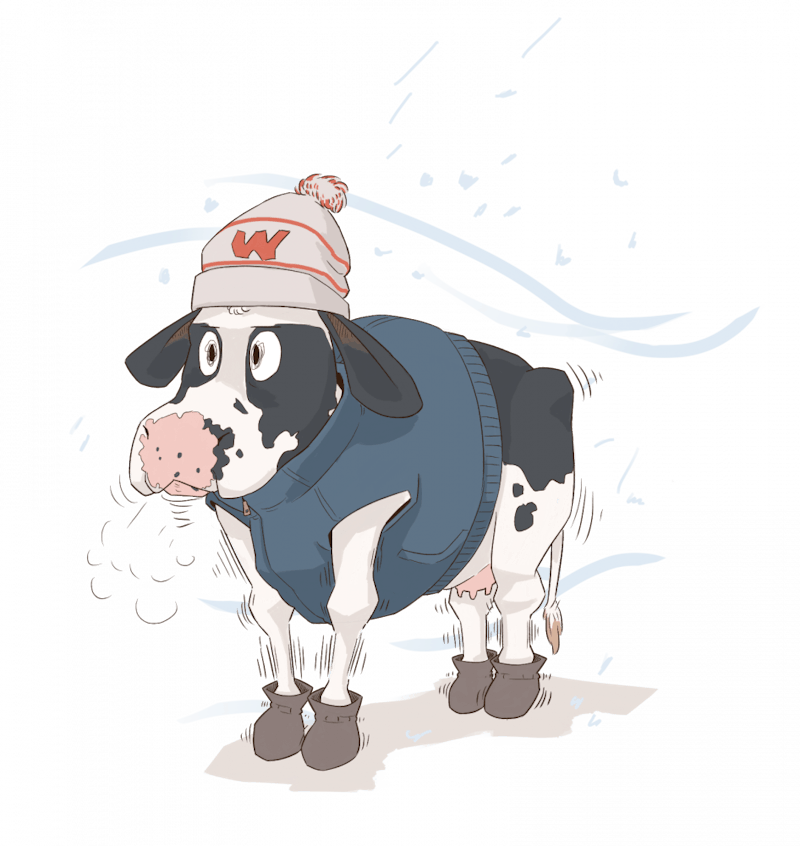
Effects of climate change put additional financial burden on Wisconsin dairy farmers amidst industry collapse; small farms face the most challenges.

Effects of climate change put additional financial burden on Wisconsin dairy farmers amidst industry collapse; small farms face the most challenges.
Jim Goodman was a dairy farmer for more than 40 years. He retired in the summer of 2018, labeling the work an “economic suicide.”
Declining milk prices, overproduction and the results of a changing climate are creating a perfect storm for small dairy farmers across the state, changing the dairy industry in Wisconsin.
“We had a small heard, and I knew all the cows individually,” Goodman said. “I suppose it would be like someone having to sell a pet that they really liked, only there were 46 of them.”
Goodman was glad he kept his farm small while he still had it, saying he wanted to make sure he always gave his cows names, not numbers.
The drop in domestic demand for dairy products is creating financial stress for small farmers, making it more difficult for them to put money aside to grapple with the increasing effects of climate change.
Some farmers, like Goodman, chose to “get out before it’s too late.” He said the effects of climate change would have had negative impacts for his family operation if he hadn’t chosen to retire when he did.
Experts point to the effect of declining milk prices and an uncontrolled increase in milk production to explain the struggles small farmers face.
Small farms cede to industrial farms as financial pressure climbs
According to Mark Stephenson, director of dairy policy analysis at UW-Madison, the rate of farm closures doubled this year alone.
“We are seeing many more farms exiting the industry this year than what is normal for us,” Stephenson said. “It’s typical for us to lose between 3 and 4 percent of dairy farms. Now we are losing 8 percent.”
Milk production skyrocketed over the past five years, and the processing infrastructure has had a difficult time keeping up, Stephenson said. When processing plants have more milk to buy, there is less reason for them to be competitive with prices, which causes a loss for producers.
He said this model favors larger producers and small family-run operations get the short end of the stick.
“Larger farms may be sending multiple tanker-truck loads of milk out a day,” Stephenson said. “That same truck might have to go to a dozen smaller farms to get enough milk, and that becomes costly.”
Changes within the industry affect animals in addition to the financial instability of farmers. When family farms close, dairy cows are sometimes sold to larger farms, other times they are slaughtered.
“If you do take a look at the dairy cattle slaughter rate, it is up,” Stephenson said. “Increasingly we are seeing more cows that are completely exiting production. That's reflective of an industry that is starting to entrench.”
Keeping up with the changing demand is already challenging for dairy farmers in the midwest –– before trying to tackle the obstacles that climate change can create.
Increase in extreme weather events puts struggling small farmers in a further bind
In Wisconsin, rainfall on the wettest days of the year increased by 35 percent over the past 50 years. During the next century, the Environmental Protections Agency found spring rainfall and annual precipitation is likely to increase, and heavy storms are likely to become more intense.
Kenneth Potter, professor of environmental engineering at UW-Madison, said more rainfall in the spring has increased the risks of flooding, especially in rural areas. River flooding can severely impact farmlands, most of which are situated in naturally occuring floodplains, low-lying ground near easily-flooded rivers.
“My concern is preventing new development from increasing flood risk,” Potter said.
It is important to invest in sustainable initiatives to prevent future damage, even when the benefits won’t show for many years, according to Potter.
However, this poses an economic commitment that isn’t feasible for many struggling farms.
Potter said while efficiency is important, there is often a trade-off between efficiency and equity when it comes to sustainability efforts. He finds an analogy between investing money to mitigate future damage from climate change to putting money away for college from a young age.
“It isn't just about efficiency,” Potter said. “None of us would want to have done something that, 50 years from now, would cause mass disease or flooding just because we were being selfish.”
Adapting to climate change takes extensive planning and budgeting for the future on the part of the farmers. With farmers focusing on upcoming yields year after year, sustainable agriculture efforts become a financial burden.
However, increases in precipitation and severe flooding are not the only conditions threatening the success of dairy farmers. Extreme weather on the other side of the spectrum can be just as damaging.
As the climate becomes warmer, high temperatures and droughts hit the southern U.S. more frequently. Goodman said he is concerned for farmers in other states that are being affected by changing temperatures.
“These are the farmers that don’t want to produce for the world market, all they want to do is feed their families,” Goodman said. “In their situation with drought and excessive heat, it’s really difficult for them.”
Goodman said it remains important to him to make a difference for other farmers who are working in the industry, even though he is retired.
Goodman and his wife, Rebecca, serve on the executive board for Family Farm Defenders, a nonprofit based in Madison.
The grassroots organization’s mission is to advocate for a farmer-controlled and consumer-oriented food and fiber system, which would empower farmers to speak up and defend themselves within the industry. The organization supports sustainable agriculture, farm workers’ rights and fair trade, among other key values.
“We all have to do what we can to change things,” Goodman said.